Introduction
Ectopic pregnancy refers to the embryo implant other than the uterine cavity, the most common place of occurrence is the ampulla of the fallopian tube, only 3.2% of ectopic pregnancies occur in the interstitial part of the fallopian…

Ectopic pregnancy refers to the embryo implant other than the uterine cavity, the most common place of occurrence is the ampulla of the fallopian tube, only 3.2% of ectopic pregnancies occur in the interstitial part of the fallopian…
NASA said Monday it was opening the marquee U.S. moon landing contract to other bidders because Elon Musk’s SpaceX has experienced mounting delays with its…

Tonight at the premiere for HBO’s IT: Welcome to Derry, Andy and Barbara Muschietti, the Argentina-born, producer-director siblings, offered insight into the real-life relevance of the horror genre and Stephen Kings’s novel,…
This request seems a bit unusual, so we need to confirm that you’re human. Please press and hold the button until it turns completely green. Thank you for your cooperation!
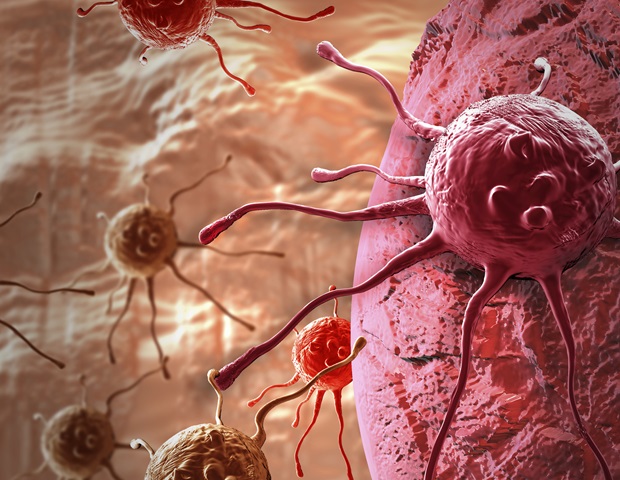
In a city, coworking hubs bring people and ideas together. Inside cancer cells, similar hubs form-but instead of fueling progress, they supercharge disease. That’s what researchers at the Texas A&M University Health Science Center…

The data pertaining to the effect of urea phosphorus (UP) fertilizer rates on growth and physiological parameters, such as relative chlorophyll content (SPAD reading), plant height (PH), leaf area (LA), and plant dry matter percentage (DrM%), of salt-stressed soybean plants in the 2022 and 2023 growing seasons are graphically presented in Fig. 2 (A-D). The results obtained indicate that the maximum values in PH (72.11 vs. 75.14 cm) and LA (34.22 vs. 39.72 cm2) in both growth seasons were recorded in plants fertilized with UP3; moreover, the maximum value in SPAD (53.67) was recorded in the second season. Meanwhile, the application of the UP1 significantly increased DM% compared to higher UP levels. So, the highest values in DrM% were recorded in both growing seasons (57.55 vs. 58.80% in 2022 and 2023, respectively). On the other hand, UP1 was the least influential variable on PH (54.11 vs. 52.41 cm) and LA (18.01 vs. 19.79 cm²) in the first and second seasons and the least influential on SPAD readings (43.67) in the second season. The lowest DrM% values (42.50 vs. 43.04%) in both seasons and the lowest SPAD reading (42.47) in the first season were produced by plants treated with UP2. The analysis of variance presented a significant effect (at p ≤ 0.01) on LA in the 2023 season and a significant impact (at p ≤ 0.05) on PH in the second season and on LA in the first season. In addition, a non-significant influence was demonstrated by the SPAD reading and DrM% in both growing seasons, as well as by pH in the first season.
A–D The individual effect of urea-phosphate fertilizer rates (UPs) on 1 A) SPAD reading, 1B) Plant height, 1 C) leaf area, and 1D) leaf dry matter percentage (DrM%) of soybean plants cultivated in saline soil in both growth seasons 2022 and 2023, respectively. UP1, UP2, UP3, and UP4 represent urea-phosphate at 85.0, 107.0, 127, and 150.0 kg ha−1, respectively. The data are means±SE (Standard Error) for three replicates. Means value that have different lower-case letter in each season are significant at p ≤ 0.05 according to Duncan’s multiple range test
Figure 3 (A-D) graphically display the maximum values recorded in the leaves treated with MgONP2 in terms of SPAD readings (47.00 vs. 51.00 in 2022 and 2023, respectively), PH (64.08 vs. 67.57 cm in 2022 and 2023, respectively), and %DrM (56.63 vs. 55.81% in 2022 and 2023, respectively) in the first and second seasons. The highest LA values were achieved in the plants sprayed with MgONP1 (28.68 vs. 31.51 cm² in the 2022 and 2023 growing seasons, respectively). In contrast, the minimum values in terms of the SPAD readings (43.72 vs. 47.25 in 2022 and 2023, respectively) and PH (57.50 vs. 54.32 cm in 2022 and 2023, respectively) were produced in the untreated plants (MONP0) in both seasons. In addition, the lowest LA (23.80 vs. 24.12 cm² in 2022 and 2023, respectively) and DrM% (46.40 vs. 46.35% in 2022 and 2023, respectively) values in the 2022 and 2023 growth seasons were obtained in the plants treated with MgONP2 and MgONP1, respectively. Statistically, highly significant increases were recorded in the SPAD readings in 2022 and in the PH and LA values in 2023 following all the treatments. These treatments had no significant impacts on the PH or LA values in the first season or on the SPAD readings in the second season.
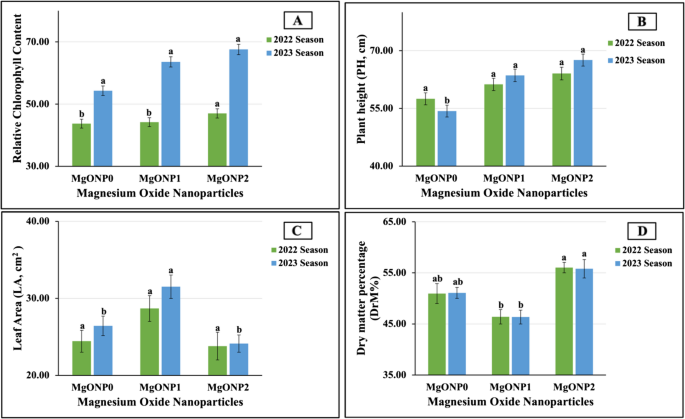
A–D The individual effect of magnesium oxide nanoparticle doses (MgONPs) on (A) SPAD reading, B Plant height, C leaf area, and D dry matter percentage of soybean plants cultivated in saline soil in both growth seasons 2022 and 2023, respectively. The data are means ± SE (Standard Error) for three replicates. Means value that have different lower-case letter in each season are significant at p ≤ 0.05 according to Duncan’s multiple range test
The results, as observed in Table 4, demonstrate the enhanced impact of interaction between UP rates and MgONP doses on some growth and physiological traits. Similar findings were obtained for PH, LA, and DrM% in plants fertilized with UP3 and sprayed with MgONP2 (T32), plants treated with UP3 and foliarly sprayed with MgONP1 (T31), and plants fertilized with UP1 combined with MgONP2 (T12) treatments produced the maximum values in PH (81.33 vs. 83.37 cm), LA (44.92 vs. 54.63 cm²), and DrM% (65.41 vs. 62.51%) in the first and second seasons, respectively. Dissimilar data were recorded regarding the highest values in SPAD readings (53.25 vs. 83.37); however, in both seasons, the plants treated with T12 and T32 produced the best results. On the hand, the minimum values in PH (44.00 cm) in the second seasons and in SPAD readings (39.46) in the first season were obtained in plants fertilized with UP1 combined with MgONP1 (T11). Meanwhile, plants treated with UP2 and MgONP1 (T21) produced the lowest %DrM (38.33 and 38.40%) in both seasons. In addition, the lowest values in LA (15.65 cm²) in the 2022 season and in SPAD readings (40.00) in the 2023 season were recorded in plants fertilized with UP1 only, without using MgONP (T10). Furthermore, applying UP4 with MgONP (T42) was the least impactful on LA in the second season. There were highly significant differences among the treatments in SPAD readings in the first season and in LA in the second season. Non-significant differences were observed in SPAD readings in the second season, in LA in the first season, as well as in PH and %DrM in both seasons.
The results, as graphically presented in Fig. 4(A-E), indicated that UP4 was the best application rate for soybean leaf nitrogen (LNC), phosphorus (LPC), potassium (LKC), calcium (LCaC), and magnesium (LMgC). However, this treatment produced the maximum values of 4.88 vs. 3.70% for LNC, 0.48 vs. 0.45% for LPC, 3.56 vs. 3.11% for LKC, 0.63 vs. 0.65% for LCaC, and 0.30 vs. 0.32% for LMgC in the first and second seasons, respectively. In addition, the plant leaves fertilized with UP1 and UP2 recorded the highest leaf sodium values (LNaC), recording 0.04% in both seasons, respectively. In contrast, the lowest leaf contents of N (4.18 vs. 3.00%), P (0.31 vs. 0.30%), Ca (0.49 vs. 0.50%), and Mg (0.22 vs. 0.20%) were recorded in plants fertilized with UP1 and UP2 in the 2022 and 2023 growth seasons, respectively. Moreover, UP2 and UP1 for LKC as well as UP4 and UP3 for LNaC, were the least impactful, demonstrating 2.75 vs. 2.30% and 0.03 vs. 0.02% for both elements in both seasons, respectively. For all the UP rates tested, highly significant differences were obtained for the above-mentioned nutrients, except for LNaC, which had a non-significant effect in both seasons.
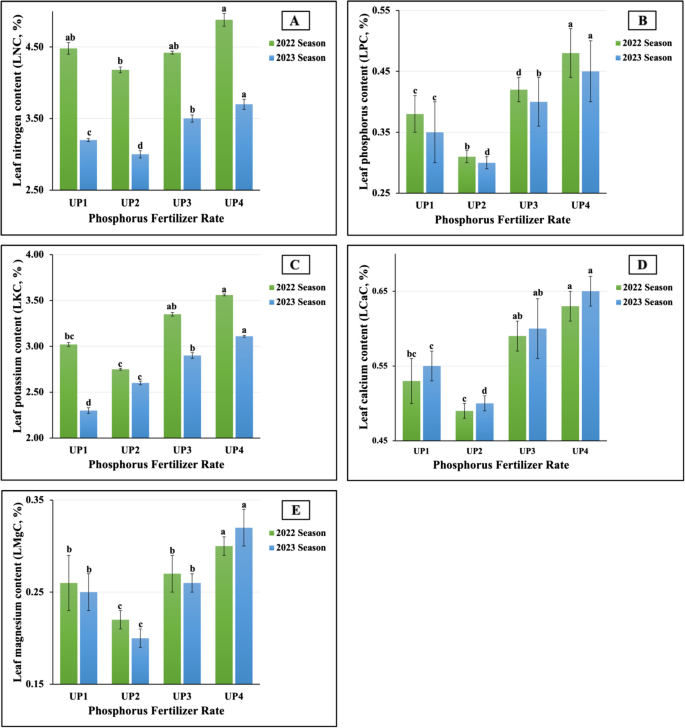
A–E The individual impact of urea-phosphate types (UPs) on leaf macronutrients content; (3A) nitrogen (LNC), (3B) phosphorus (LPC), (3C) potassium (LKC), (3D) calcium (LCaC), and (1E) magnesium (LMgC) of soybean plants cultivated in saline soil in two growing seasons 2022 and 2023 growing seasons. The data are means ± SE (Standard Error) for three replicates. Means value that have different lower-case letter in each season are significant at p≤0.05 according to Duncan’s multiple range test
As seen in Fig. 5(A-D), the results related to the impact of UP fertilizer rates on the content of leaf micronutrients, such as iron (LFeC), manganese (LMnC), zinc (LZnC), and copper (LCuC), demonstrated that the plants fertilized with UP4 produced the maximum content of Mn (70.42 vs. 72.43 mg kg−1) in both seasons and of LZnC (36.77 mg kg−1) in the second season. Meanwhile, the plants treated with UP2 produced the highest LCuC (25.00 vs. 23.65 mg kg−1) in both growing seasons and the highest LFeC in the second season (113.72 mg kg1). Furthermore, UP was the most influential on LFeC (114.33 mg kg−1) and LZnC (35.99 mg kg−1) in the first season. On the contrary, UP3 were the least impactful, demonstrating the minimum values in LMnC (47.33 vs. 48.22 mg kg−1 and LCuC (15.30 vs. 13.15 mg kg−1) in both growing seasons, respectively, and the minimum value in LFeC (93.30 mg kg−1) in the first season. The lowest LZnC (31.86 vs. 32.82 mg kg−1 in 2022 and 2023, respectively) was obtained in plants treated with UP2 in both growth seasons. Statistically, highly significant differences were found for LFeC, LMnC, and LCuC; moreover, non-significant effects were found for LZnC in both growth seasons.
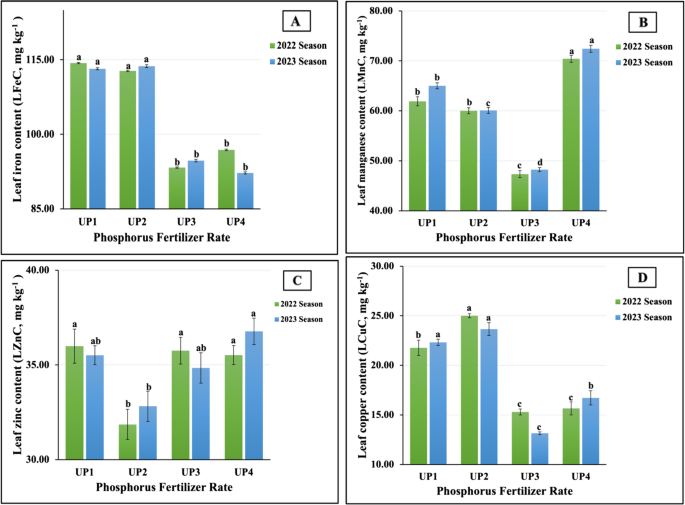
A–D The individual impact of urea-phosphate rates (UPs) on leaf micronutrients content; (4A) iron (LFeC), (4B) manganese (LMnC), (4 C) zinc (LZnC), and (4D) copper (LCuC) of soybean plants cultivated in saline soil in the 2022 and 2023 growing seasons. The data are means ± SE (Standard Error) for three replicates. Means value that have different lower-case letter in each season are significant at p ≤ 0.05 according to Duncan’s multiple range test
The impact of the application of MgONP doses on the leaf contents of the aforementioned macronutrients in the 2022 and 2023 seasons are graphically presented in Fig. 6(A-E). Similar findings were obtained for LPC, LCaC, and LMgC. The MgONP doses, ranked in descending order in terms of MgONP2 > MgONP1 > MgONP0, were 0.47 > 0.41 > 0.35 and 0.43 > 0.37 > 0.32 for LPC, 0.62 > 0.56 > 0.51 and 0.63 > 0.58 > 0.63 for LCaC, and 0.31 > 0.27 > 0.22 and 0.30 > 0.26 > 0.20 for LMgC in each growth season, respectively. With regard to LNaC, the doses of MgONPs were arranged in the following order (for MgONP0 > MgONP1 > MgONP2): 0.04 > 0.03 > 0.02 and 0.04 > 0.04 > 0.03 in the 2022 and 2023 growing seasons, respectively. Dissimilar results were achieved in both growth seasons for LNC and LKC. However, the results for treatment with MgONPs were ranked as, in descending order, MgONP2 (4.58%) > MgONP0 (4.47%) > MgONP1 (4.42%) and MgONP2 (3.55%) > MgONP1 (3.35%) > MgONP0 (3.15%) for LNC and as MgONP1 (3.23%) > MgONP2 (3.19%) > MgONP0 (3.09%) and MgONP2, (2.83%) > MgONP1 (273%) > MgONP0 (2.63%) for LKC in the 2022 and 2023 seasons, respectively.
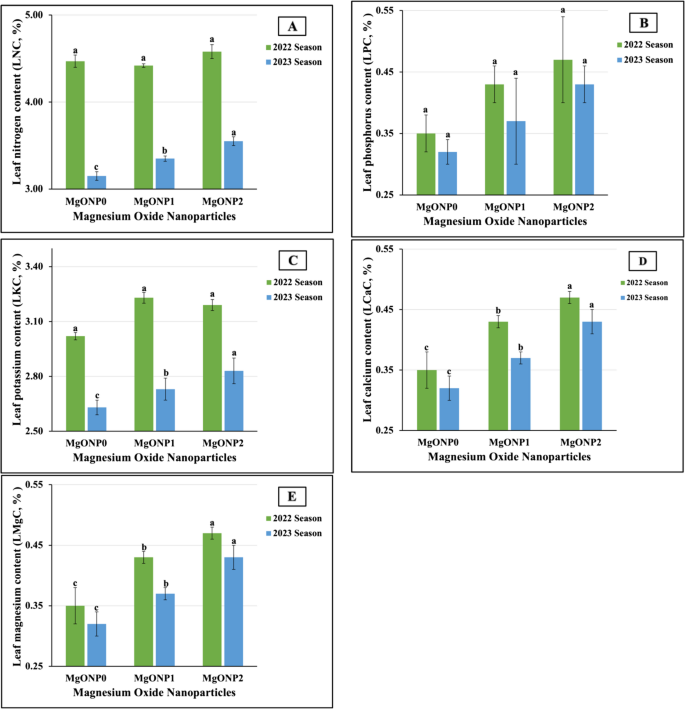
A–E The individual impact of magnesium oxide nanoparticle doses (MgONPs) on leaf macronutrients content; (3A) nitrogen (LNC), (3B) phosphorus (LPC), (3C) potassium (LKC), (3D) calcium (LCaC), and (1E) magnesium (LMgC) of soybean plants cultivated in saline soil in two growing seasons 2022 and 2023 growing seasons. The data are means ± SE (Standard Error) for three replicates. Means value that have different lower-case letter in each season are significant at p≤0.05 according to Duncan’s multiple range test
The results obtained from the ANOVA showed that MgONPs had highly significant influences on the leaf content of P, Ca, and Mg in both seasons, of LNC and LKC in the 2023 season, and of LNC in the 2022 season. Non-significant differences were found for LNC and LKC in the first season. The results depicted in Fig. 7(A-D) document the effect of treatment with different MgONPs on the micronutrient contents of soybean leaves during the 2022 and 2023 seasons.
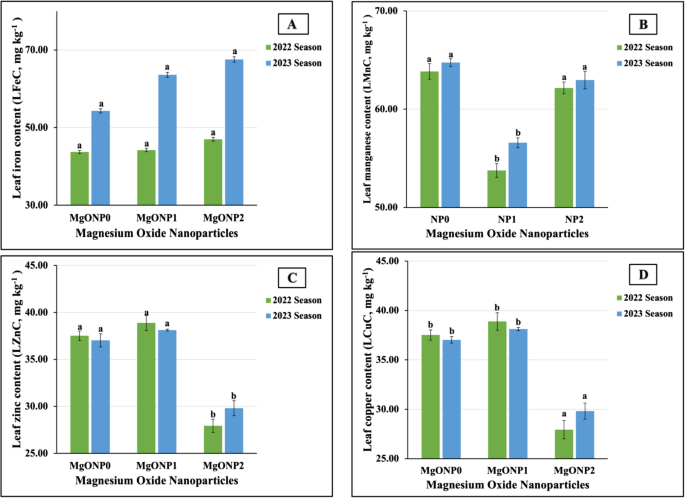
A–D The individual impact of magnesium oxide nanoparticle doses (MgONPs) on leaf micronutrients content; (6A) iron (LFeC), (6B) manganese (LMnC), (6C) zinc (LZnC), and (6D) copper (LCuC) of soybean plants cultivated in saline soil in the 2022 and 2023 growing seasons. The data are means ± SE (Standard Error) for three replicates. Means value that have different lower-case letter in each season are significant at p≤0.05 according to Duncan’s multiple range test
The statistical analysis revealed that MgONPs did not have a significant impact on LFeC and had highly significant influences on LMnC, LZnC, and LCuC in both growth seasons. The obtained results demonstrated that the highest LMnC values (63.84 vs. 64.75 mg kg−1) were produced in untreated plants. Meanwhile, the plants treated with MgONP2 and MgONP1 produced the maximum LFeC in two growing seasons. Regarding the highest values of LZnC and LCuC, our results noted that MgONP1 for LZnC and MgONP2 for LCuC were the most impactful, producing levels of 38.89 vs. 38.12 mg kg1 and 23.08 vs. 22.10 mg kg−1 in the 2022 and 2023 seasons, respectively. On the contrary, the lowest LFeC (100.64 vs. 103.04 mg kg−1) and LCuC (16.91 vs. 17.26 mg kg−1) were obtained in untreated plants. Furthermore, the least influence of fertilizer on LMnC and LZnC levels was found in plants fertilized with MgONP1 and MgONP2, respectively; the minimum values in both growing seasons were recorded in these plants.
Despite the improvements obtained due to the interactive impact between UP and MgONP, the results obtained from the statistical analysis indicated that there were no significant effects on all the macronutrients studied. The finding obtained from our field study highlighted the pivotal influence of using maximum rates of both UP and MgONP5, as listed in Table 5. More clearly, the maximum contents of N (5.52 vs. 3.90% in the 2022 and 2023 seasons, respectively), P (0.54 vs. 6.50% in the 2022 and 2023 seasons, respectively), Ca (0.67 vs. 0.70% in the 2022 and 2023 seasons, respectively), and Mg (0.36 vs. 0.34% in the 2022 and 2023 seasons, respectively) were recorded in soybean plants fertilized with UP4 and foliarly sprayed with MgONP2. Similarly, plants treated T20 produced the highest values in Na (0.05 vs. 0.04% in 2022 vs. 2023) in both seasons. For LKC, dissimilar results were produced among both growth seasons, as the highest values of K were found in the leaves of plants treated with T41 (3.64%) in the first season and in those treated with T42 (3.20%) in the second season. As for the lowest values obtained, the results were completely different. However, the T20 treatment was the least influential for LCaC (0.44 vs. 0.45%), LMgC (0.20 vs. 0.19%), and LPC (0.29 vs. 0.25%) in both growing seasons and for LNC (2.80%) and LKC (2.20%) in the second season. Furthermore, the application of T21 produced the lowest values in LNC (3.70%) and LKC (2.66%) in the first season, while plants treated with T42 produced the minimum LNaC values (0.01 vs. 0.02% in the 2022 and 2023 growth seasons, respectively). It is clear from Table 6 that the interaction between UP and MgONP significantly affected the leaf micronutrient content in soybean plants. The obtained results indicated that the application of T20 and T10 treatments was the most influential on LFeC (140.01 vs. 144.71 mg kg−1) and LMnC (93.43 vs. 96.87 mg kg−1) in the 2022 and 2023 seasons, respectively. Dissimilar results were found for LZnC and LCuC during both growth seasons. However, the maximum values in LZnC (52.32 vs. 51.75 mg kg−1) were produced in plants treated with T31 and T11. Likewise, the plants treated with T12 and T11 demonstrated the highest LCuC values (30.00 vs. 29.42 mg kg−1) in both seasons. In spite of the clear variation in the best values obtained, the values associated with the lowest were similar to each other. However, the plants treated with T40, T32, and T31 demonstrated the lowest values in Fe (53.24 vs. 51.50 mg kg−1), Mn (22.80 vs. 21.68 mg kg−1), and Cu (19.20 vs. 8.20 mg kg−1) in the first and second seasons. The application of T30, and T12 treatments was the least impactful on LZnC levels of 22.27 and 21.37 mg kg−1 were recorded in the 2022 and 2023 seasons, respectively.
Figure 8(A-E) present the influences of the application of the different rates of UP as a soil fertilizer on the macronutrient contents of the seeds in the 2022 and 2023 seasons. According to the results, there was no noticeable benefit from adding any particular treatment over the others. However, the plants fertilized at UP1 produced the maximum seed nitrogen (SNC) and calcium (SCaC) contents, recording 6.62% and 0.40%, respectively, in the 2022 season, as well as a seed potassium content (SKC) of 1.78% in the 2023 season. In addition, UP₃ was the most impactful rate for the seed magnesium content (SMgC), which was recorded as 0.43% in the first season, and for the seed phosphorus (SPC) (0.61%) and SCaC (0.34%) in the second season. Meanwhile, UP4 was the superior rate, producing the maximum SKC value (1.71%) in the first season, as well as the highest SNC (6.46%) and SMgC (0.42%) values in the second season.
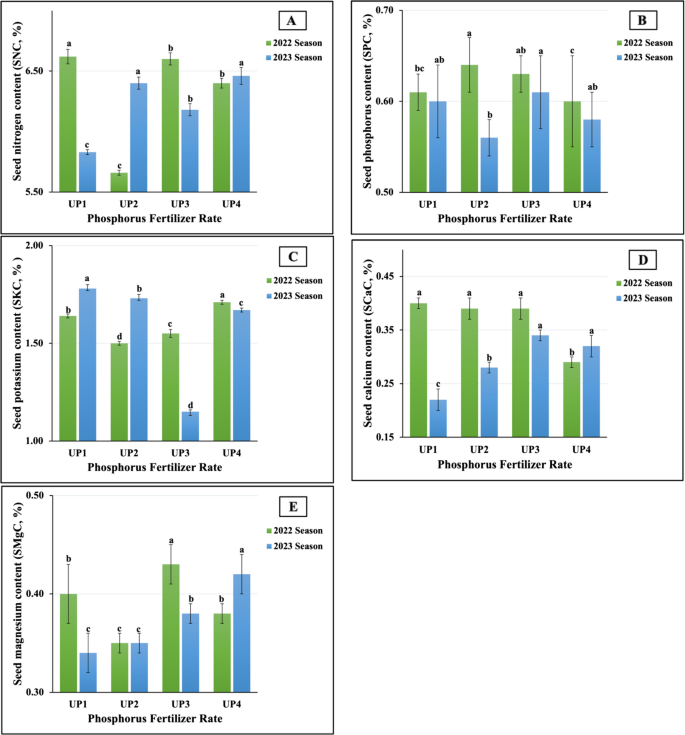
A–E The individual impact of urea-phosphate types (UPs) on seed macronutrients content; (8A) nitrogen (SNC), (8B) phosphorus (SPC), (8C) potassium (SKC), (8D) calcium (SCaC), and (8E) magnesium (SMgC) of soybean plants cultivated in saline soil in two growing seasons 2022 and 2023 growing seasons. The data are means ± SE (Standard Error) for three replicates. Means value that have different lower-case letter in each season are significant at p≤0.05 according to Duncan’s multiple range test
In contrast, UP₂ was the least influential for the SMgC (0.35 vs. 0.33%) contents in both growth seasons, as well as for the SNC (5.66%) and SKC (1.50%) in the first season and the SPC (0.56%) in the second season. The lowest SNC (5.83%) and SCaC (0.22%) values were obtained in the plants treated at UP1 in the second season. Furthermore, the application of UP4 produced the minimum SPC (0.60%) and SCaC (0.29%) values in the first season. The results obtained from the ANOVA indicated that all the treatments had highly significant influences on the SNCs, SKCs, SCaCs, and SMgCs; in addition, significant effects on the SPCs were observed in both seasons. The results presented in Fig. 9(A-D) reveal the beneficial effect that UP₂ exerted on the micronutrient contents of the seeds. The highest iron (SFeC) and zinc (SZnC) contents were recorded in both growing seasons (78.39 vs. 77.48 mg kg⁻¹ for the SFeC and 36.44 vs. 34.82 mg kg⁻¹ for the SZnC in 2022 and 2023, respectively). Moreover, the maximum seed manganese contents (SMnCs) were recorded in the plants fertilized at UP4 (42.45 vs. 43.55 mg kg⁻¹ in 2022 and 2023, respectively). Dissimilar findings were obtained for the seed copper contents (SCuCs); however, the highest values were produced as a result of applying UP2 and UP3 in both seasons, 2022 and 2023, respectively. In contrast, the UP1 application was the least influential; the minimum SFeC (69.25 vs. 65.26 mg kg⁻¹), SMnC (26.56 vs. 25.03 mg kg⁻¹), and SCuC (10.71 vs. 10.98 mg kg⁻¹) values were recorded in the plants treated at UP1 in both growth seasons, respectively. Meanwhile, the lowest SZnC values were achieved in the plants treated at UP4 (25.00 vs. 25.69 mg kg⁻¹ in 2022 and 2023, respectively). Statistically, all the treatments had significant impacts (at p ≤ 0.01) for all the aforementioned micronutrients in the first and second seasons.
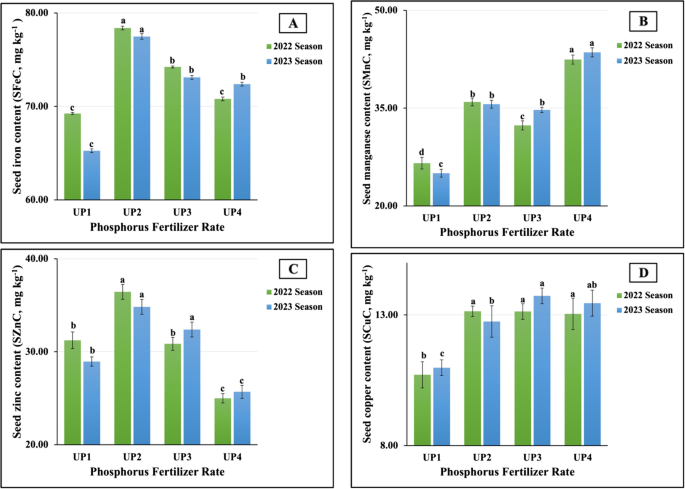
A–D The individual impact of urea-phosphate rates (UPs) on seed micronutrients content; (9A) iron (SFeC), (9B) manganese (SMnC), (9C) zinc (SZnC), and (9D) copper (SCuC) of soybean plants cultivated in saline soil in the 2022 and 2023 growing seasons. The data are means ± SE (Standard Error) for three replicates. Means value that have different lower-case letter in each season are significant at p≤0.05 according to Duncan’s multiple range test
The results obtained from the statistical analysis indicated that all MgONPs treatments had significant impacts (at p ≤ 0.01) on all studied macronutrient content levels in both growth seasons. As graphically presented in Fig. 10(A-E), the greatest improvements in the macronutrient content of leaves were closely associated with the application of MgONP1 and MgONP2 treatments, whereas the maximum values in SNC (6.40 vs. 6.35%) in both seasons, as well as in SPC (0.66%) in the first season and in SKC (1.68%) and SMgC (0.38%) in the second season were achieved in soybean plants that were foliar applied with MgONP1. Furthermore, the highest values in SCaC (0.40 vs. 0.33%) in both growing seasons and the highest value in SMgC (0.42%) in the 2022 season and in SPC (0.66%) in the 2023 season were achieved in plants treated with MgONP₂. The highest SKC value (1.75) in the first season was obtained in untreated plants. Conversely, the lowest values in SNC (6.25 vs. 6.07%), SPC (0.56 vs. 051%), SCaC (0.33 vs. 0.26), and SMgC (0.36 vs. 6.34%) were obtained in untreated plants (MgONP0). Dissimilar findings were produced regarding SKC, as the minimum values were recorded as a result of MgONP1 in the first season and as a result of MgONP2 in the second season.
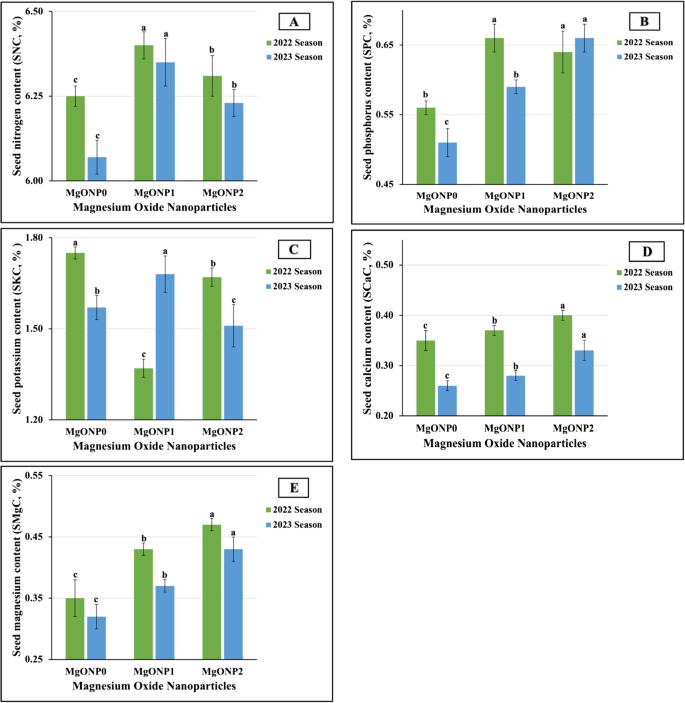
A–E The individual impact of magnesium oxide nanoparticle doses (MgONPs) on seed macronutrients content; (10A) nitrogen (SNC), (10B) phosphorus (SPC), (10C) potassium (SKC), (10D) calcium (SCaC), and (10E) magnesium (SMgC) of soybean plants cultivated in saline soil in two growing seasons 2022 and 2023 growing seasons. The data are means ± SE (Standard Error) for three replicates. Means value that have different lower-case letter in each season are significant at p≤0.05 according to Duncan’s multiple range test
The results presented in Fig. 11(A-D) reveal that following the application of MgONPs as a foliar application, the levels of micronutrients in the leaves of all studied plants significantly improved. The results indicated that for SFeC and SMnC, the MgONP doses, in descending order, were ranked as follows: MgONP1 > MgONP0 > MgONP2, recording 84.41 > 69.41 > 65.68 mg kg−1 vs. 84.03 > 68.20 > 63.95 mg kg−1 for SFeC and 36.55 > 36.01 > 30.40 mg kg−1 vs. 36.98 > 35.64 > 31.56 mg kg−1 for SMnC in both seasons, respectively. Similarly, for SZnC, the MgONP doses were ranked in descending order as follows: MgONP2 (34.09 vs. 34.36 mg kg−1) > MgONP1 (30.21 vs. 30.13 mg kg−1) > MgONP0 (28.34 vs. 26.90 mg kg−1) in 2022 and 2023, respectively. Meanwhile, the MgONP doses can be arranged in descending order as MgONP1 (15.16 vs. 14.67 mg kg−1) > MgONP2 (12.33 vs. 12.76 mg kg−1) > MgONP0 (10.03 vs. 10.75 mg kg−1) for SCuC in both growth seasons, respectively. The statistical analysis identified highly significant influences of MgONP doses on all studied leaf contents of micronutrients.
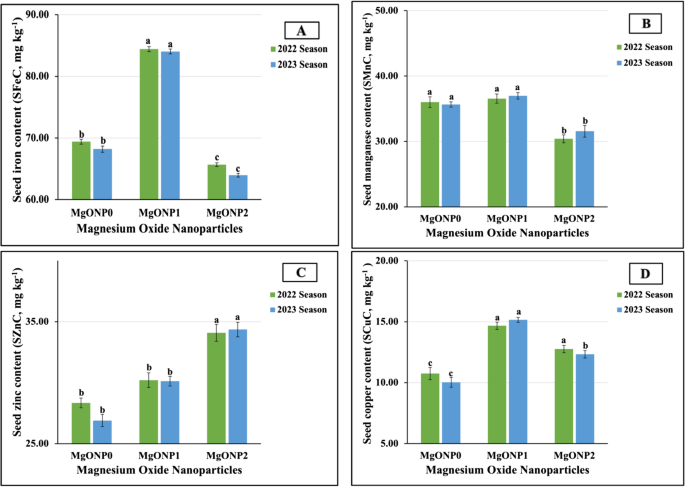
A–D The individual impact of magnesium oxide nanoparticle doses (MgONPs) on seed micronutrients content; (11A) iron (SFeC), (11B) manganese (SMnC), (11C) zinc (SZnC), and (11D) copper (SCuC) of soybean plants cultivated in saline soil in the 2022 and 2023 growing seasons. The data are means ± SE (Standard Error) for three replicates. Means value that have different lower-case letter in each season are significant at p≤0.05 according to Duncan’s multiple range test
The data presented in Table 7 indicate that all studied leaf macronutrient content levels were markedly enhanced as a result of interaction between UP fertilizer rates and MgONP doses. Our investigation demonstrated that the highest values (6.92 vs. 6.96%) in SNC in both growing seasons and in SKC (2.01%) in the second season were recorded in plants fertilized with the T41 treatment. In addition, the maximum values in SPC (0.70%) and SMgC (0.50%) in the second season were associated with the application of T42. Furthermore, the plants treated with T21 produced the highest values in SPC (0.71%) and SCaC (0.47%) in the first season. Moreover, the use of the T30 treatment was the most significant for LKC (2.01%) and LMgC (0.46%) levels in the first season. Dissimilar results were obtained regarding the lowest values in seed macronutrient contents, as the plants treated with T40 demonstrated the minimum values in SNC (5.51%) and LPC (0.52%) in the first season, while the plants fertilized with T10 demonstrated the lowest mean values for SCaC (0.21%) and for SMgC (0.31%) in the second season. In addition, the application of T12, T30, and T31 produced the minimum values in SNC (5.55%), SPC (0.50%), and SKC (1.02%), respectively in the second season. The analysis of variance indicating that all interaction treatments had highly significant effects on all aforementioned levels of macronutrient content. According to the results listed in Table 8, the highest values in SFeC (95.02. vs. 98.88 mg kg−1) in both seasons and the highest levels of SMnC (50.00 mg kg−1) in the 2022 season and of SCuC (19.75 mg kg−1) in the 2023 season were achieved in the plants fertilized with T41. Furthermore, the maximum SZnC (38.91 mg kg−1) and SCuC (19.87 mg kg−1) was recorded during the first season in plants treated with T22. The application of T32 was the most impactful on SMnC (49.53 mg kg−1) and SZnC (42.24 mg kg−1) in the second season. On the other hand, the lowest values in SMnC (18.57 vs. 16.87 mg kg⁻¹) and SCuC (5.00 vs. 5.89 mg kg⁻¹) in 2022 and 2023, respectively were obtained in plants treated with T₁₂ and T₂₀. Meanwhile, the plants fertilized with T42 demonstrated the lowest value in SFeC (55.33 mg kg⁻¹) in the second season and in SZnC (20.72 mg kg⁻¹) in the first season. Moreover, the application of T30 and T₁₀ produced the lowest values in SFeC (54.49 mg kg⁻¹) in the first season and in SZnC (20.17 mg kg⁻¹) in the second season.
The results obtained from the ANOVA clearly indicated that all UP treatments had highly significant effects on 100-seed weight (HSW), seed oil content (SOC), seed protein content (SPC), and total seed yield (TSY) in both growth seasons. As visually evident in Fig. 12(A-D), the highest values in SOC (20.09 vs. 20,18%) were produced in plants fertilized with UP3 in both growing seasons. Meanwhile, the maximum values in HSW (17.82 vs. 17.60 g) and TSY (4.66 vs. 4.87ton ha−1) in the 2022 and 2023 seasons, respectively were obtained in plants treated with UP4. Although UP4 had a profound impact on SPrC in the second season, the use of UP1 produced the highest value in the first season. Similarly, the lowest values in HSW (15.06 vs. 15.08 g) and TSY (3.82 vs. 4.01ton ha−1) were obtained in plants treated with UP2, while the application of UP1 produced the lowest SOC (19.26%) in the first season and the lowest SPC (36.45%) in the second season. Simultaneously, the use of UP2 produced the minimum values in SPrC (35.39%) in the first season and the minimum value in SOC (19.49%) in the second season.
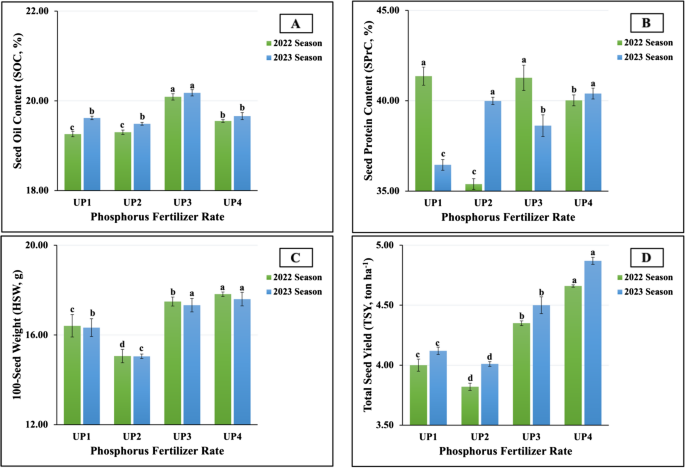
A–D The individual impact of urea-phosphate rates (UPs) on (12A) SOC, (12B) SPrC, (12C) HSW, and (12D) TSY of soybean plants cultivated in saline soil in the 2022 and 2023 growing seasons. The data are means ± SE (Standard Error) for three replicates. Means value that have different lower-case letter in each season are significant at p≤0.05 according to Duncan’s multiple range test
The results obtained from the statistical analysis indicated that MgONPs treatments significantly (at p ≤ 0.01) affected yield and its components. As graphically demonstrated in Fig. 13(A-D), the plants foliarly sprayed with MgONP2 produced the maximum values in SOC (19.79 vs. 19.91%) and TSY (4.55 vs. 4.74ton ha−1) in the first and second seasons. Furthermore, the highest SPrC values (40.03 vs. 39.69%) were produced in plants treated with MgONP1. Moreover, the highest values in HSW (17.38 vs. 17.04 g) were recorded in untreated plants in both growth seasons. On the other hand, MgONP2 treatment was the least influential on HSW, producing HSW levels of 16.29 vs. 16.23 g in the two growing seasons. Meanwhile, the lowest values in SPrC (39.05 vs. 37.96%), TSY (3.89 vs. 4.00ton ha−1), and SOC (19.35 vs. 19.54%) in the 2022 and 2023 seasons, respectively were obtained in untreated plants.
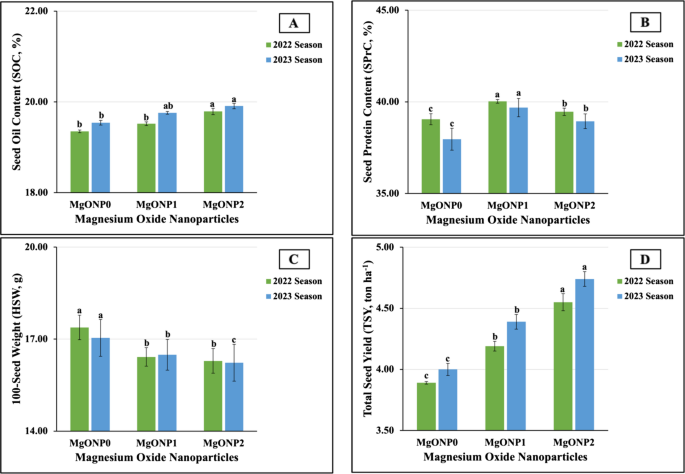
A–D The individual impact of magnesium oxide nanoparticles doses (MgONPs) on (13A) SOC, (13B) SPrC, (13C) HSW, and (13D) TSY of soybean plants cultivated in saline soil in the 2022 and 2023 growing seasons. The data are means ± SE (Standard Error) for three replicates. Means value that have different lower-case letter in each season are significant at p≤0.05 according to Duncan’s multiple range test
The data explored in Table 9 indicate that plants treated with both UP as a soil application and MgONPs as a foliar spray, irrespective of their doses, markedly outperformed the control treatment, in terms of enhanced productivity and yield-related attributes, although the ANOVA data revealed that all treatments had significant influences (at p ≤ 0.01) on the HSW, SOC, and SPC. Conversely, there were no significant impacts on TSY in both growth seasons, respectively. We found that the co-application of UP4 and MgONP1 (T41) was the superior treatment; it produced the maximum values for HSW (18.77 vs. 18.53 g) and for SPrC (43.25 vs. 43.48%) in both growing seasons. Meanwhile, the T42 treatment was the most impactful on TSY, producing the highest values (5.00 vs. 5.19ton ha−1) in both seasons, respectively. Dissimilar results were obtained for SOC; however, T31 and T40 produced the best values (20.75 vs. 21.02%) in the 2022 and 2023 seasons, respectively. Conversely, the lowest values in HSW (13.27 vs. 13.00 g) and TSY (3.54 vs. 3.62 tan ha−1) in the first and second seasons, respectively were produced in plants treated with T22 and T20. Interestingly, the application of T40 and T12 for SPrC and T11 and T41 for SOC were the least impactful, producing the minimum values for SPrC (34.42 vs. 34.67%) and SOC (18.40 vs. 18.56%) in the two growing seasons, respectively.
Principal component, Pearson’s correlation, and stepwise multiple regression analyses were performed on the physiological–growth attributes, leaf nutrient contents, and yield- and quality-related parameters of soybean plants cultivated in saline–sodic soil. Principal component analysis (PCA) was performed to evaluate the relations between the UP x MgNP interaction treatments and the abovementioned characteristics. As shown in Fig. 14, the PCA indicated that the first two main components, Dim 1 and Dim 2 (PCA-diminution 1 and -diminution 2, respectively), accounted for 48.7% of the total variation. PC1 interpreted 32.5% of the variation. The nearby vectors of the measured parameters presented a positive correlation with one another. However, the SPAD readings, PH, LA, LMgC, SPC, SCaC, SOC, and TSY fell under the same group, while the LNC, LPC, LKC, LCaC, LMnC, SNC, SMgC, SPrC, and HSW were in a separate group.
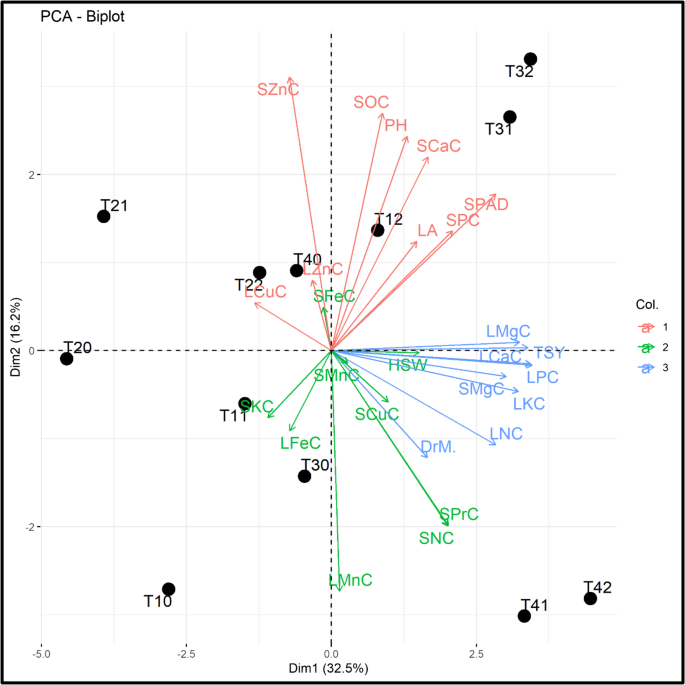
Principal component analysis (PCA) of applied urea–phosphate (UP) and magnesium oxide nanoparticle (MgONP) treatments and studied parameters. Each black dot denotes a treatment. SPAD, PH, LA, and DrM indicate the relative chlorophyll content, plant height, leaf area, and dry matter percentage, respectively. LNC, LPC, LKC, LCaC, LMgC, LFeC, LMnc, LZnC, and LCuC indicate the leaf nitrogen, phosphorus, potassium, calcium, magnesium, iron, manganese, zinc, and copper contents, respectively. SNC, SPC, SKC, SCaC, SMgC, SFeC, SMnC, SZnC, and SCuC indicate the seed nitrogen, phosphorus, potassium, calcium, magnesium, iron, manganese, zinc, and copper contents, respectively. SOC, SPrC, and TSY indicate the seed oil content, protein content, and total seed yield, respectively. Values are based on averages of two consecutive seasons (2022 and 2023). T10, T11, and T12 represent the UP applied at 85.0 kg ha−1 with three doses of MgONPs: 0.00, 50.0, and 100.0 mg L−1, respectively. T20, T21, and T22 represent the UP applied at 107.0 kg ha−1 with three doses of MgONPs: 0.00, 50.0, and 100.0 mg L−1, respectively. T30, T31, and T32 represent the UP applied at 127.0 kg ha−1 with three doses of MgONPs: 0.00, 50.0, and 100.0 mg L−1, respectively. T40, T41, and T42 represent the UP applied at 85.0 kg ha−1 with three doses of MgONPs: 0.00, 50.0, and 100.0 mg L−1, respectively
The PCA biplot in Fig. 13 shows that the SPAD, PH, LA, LMgC, SPC, SCaC, and SOC were improved by T12, T31, and T32. Moreover, the LNC, LPC, LKC, LCaC, LMnC, HSW, DrM, SNC, SMnC, and SPrC were also enhanced by T41 and T42. Therefore, the application of UP and MgONP interaction plays a crucial role in promoting most of the traits associated with the nutritional status, yield, and their components.
The results provided in Table 10 indicate the correlations of various physiological attributes that were determined (SPAD reading, LA, PH, and DrM%) and of the nutrient content in leaves (LNC, LPC, LKC, LCaC, LMgC, LFeC, LMnC, LZnC, and LCuC), with the TSY and SOC in both growth seasons, respectively. Our results revealed that SPAD readings correlated (r = 0.419* vs. 0.589** in the first and second seasons, respectively) with TSY and (r = 0.437** vs. 0.349*) with SOC in the first and second seasons, respectively. The influence of PH was found to be more correlated with SOC, with correlation values of r = 0.354* and 0.368 in the 2022 and 2023 seasons, respectively. Similarly, TSY had highly significant positive correlations with LNC (r = 0.351* vs. 0.951*), LPC (r = 0.953** vs. 0.934**), LKC (r = 0.642** vs. 0.826**), LCaC (r = 0.801** vs. 0.788**), and LMgC (r = 0.711** vs. 0.697**) in 2022 and 2023, respectively. A highly significant negative correlation of SOC was found with LMgC (r = −0.432** vs. −0.461** in 2022 and 2023, respectively).
As observed in Table 11, stepwise regression analysis clearly identified the relationship between TSY and SOC as a response variable with physiological attributes (SPAD reading and LA), leaves’ nutrient contents (LNC, LPC, LKC, LCaC, and LMnC), and yield-related attribute as predictor variables. The obtained results revealed that model 3 and model 2 were the most suitable in the 2022 and 2023 growth seasons, respectively. However, these models had high adjusted R2 0.931 (0.968) and 0.924 (0.964) and the lowest SEE (0.113 and 0.129). These results demonstrate that 93.1% of variations in TSY occurred because of variations in the combination of LPC, LA, and LCaC (TSY = 2.014 LPC + 4.842 LA + 0.004 LCaC in the first season). According to model 2, 92.4% of variations in TSY were due to variations in the combination of LNC and LKC (TSY = 0.627 LNC + 1.990 LKC). With regard to SOC, model 3 in the 2022 season and model 2 in the 2023 season were the best models owing to their maximum adjusted R2, which was recorded as 0.344 (0.618) in the first season and 0.278 (0.565) in the second season, and due to achieving the lowest SEE, which was recorded as 0.673 and 0.808 in the 2022 and 2023 season, respectively. The adjusted R2 demonstrated 34.4% and 27.8% of variations in the combination of SPAD readings, LMnC, and SOC (16.695 SPAD reading + 0.082 LMnC) in the first season and 27.8% of variations in the combinations of LMnC, HSW, and SOC (17.386 LMnC − 0.016 HSW) in the second season.
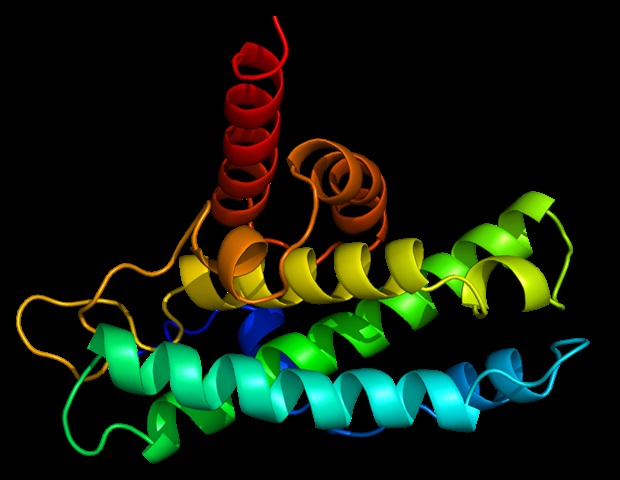
A new study led by Rice University’s Pernilla Wittung-Stafshede has revealed that protein clumps, or plaques that clog the brain, associated with Parkinson’s disease are not merely waste; they can actively drain energy from brain…

Swedish start-up Stegra is battling to avoid becoming the second multibillion-euro European green industrial project to fall into insolvency in a year.
The green steel company, which has raised $6.5bn in debt and equity, is on the ropes 11 months after battery start-up Northvolt, launched by the same Swedish financiers, went bankrupt despite raising $15bn.
While Stegra executives have told its board that “we must avoid parallels with Northvolt”, according to people familiar with the discussions, the similarities are hard to ignore as the company struggles in the face of a sudden crisis.
Stegra’s funding gap for its first green steel plant just below the Arctic Circle in Sweden has jumped to as much as €1.5bn from about €500mn as recently as July, executives told an emergency board meeting this month.
Several equity investors and multiple creditors are getting twitchy. Stegra will hold a crunch meeting with its lenders on Tuesday, several people familiar with the matter said.
Citibank is seen by Stegra, formerly known as H2 Green Steel, as particularly problematic as it has put its loans of about €29mn to the steel start-up in a workout group, according to people familiar with the matter who say some other banks share Citi’s concerns and have put Stegra into “special measures”.
“This looks more and more like Northvolt. It is hard to see anything else than equity investors getting all but wiped out,” said one person familiar with Stegra’s financing.
Lawyers from Mannheimer Swartling, one of Sweden’s leading law firms, told the emergency board meeting about the risk of insolvency and the various tests directors should apply to determine it.
They said Stegra should hold board meetings more regularly — as often as each week — to monitor its financial situation and especially its liquidity, people familiar with the meeting told the Financial Times.
The lawyers added that a board meeting should be held far enough in advance of the 12th of each month to decide whether social security fees should be paid, and also sufficiently before the 25th of each month to decide whether to pay wages, the people said.
Henrik Henriksson, Stegra’s chief executive, told the FT last week that he did not recognise “the very one-sided picture conveyed”. Stegra said on Monday it was “confident that our ongoing financing round, including opportunities for outsourcing and selected strategic partnerships, will be secured in an orderly fashion”.
It has started a new financing round aimed at raising almost €1bn and said that it had received “strong initial equity commitments from our founders and lead investors” including Altor, Just Climate, a Wallenberg family foundation and co-founder Harald Mix. “We have several avenues to pursue to manage our cash position,” it added.
But behind the scenes, Stegra is fighting to survive. A decision this year to delay a galvanisation line reduced its funding needs by about €140mn but will also lead to later deliveries for 15 of its 21 long-term customers including Volvo, Porsche and Scania, people familiar with its financing said.
People close to the company, however, said the delay would have no significant impact on customers.

Stegra is also discussing outsourcing several parts of its steel plant in Boden — which is about 60 per cent complete but has been subject to several delays — including its hydrogen and electricity plant assets, according to executives.
Such plans — to sell, and lease back or buy them as a service — could save as much as €1.3bn in capital expenditure but are likely to take until next April or May to conclude, according to information shown to the board.
It is far from clear that Stegra has that much time. The emergency board meeting two weeks ago was told that as the Boden project was consuming about €280mn a month in cash, the company only had about 1.7 months of liquidity left unless it could draw down more debt.
People familiar with its financing said that to unlock that debt Stegra needed to raise more equity, and that some investors were balking at that. Stegra said it was in talks with both existing and new investors, and was optimistic of a successful outcome.
Its funding gap — judged in July to be about €500mn — is now €1.2bn under its central scenario and €1.5bn under its worst-case scenario, according to information prepared for the board meeting.
Stegra has in recent weeks hired restructuring specialists PJT, just as Northvolt did, people familiar with the appointment said.

Both Northvolt and Stegra were started by Vargas, a Swedish private equity firm founded in 2014 by financiers Harald Mix and Carl-Erik Lagercrantz with a goal of decarbonising 1 per cent of global emissions through its projects.
Stegra’s lead shareholders include Swedish private equity group Altor, French investor Hy24, Singaporean sovereign wealth fund GIC, and fund manager Just Climate as well as Mix and Vargas.
Stegra announced on Monday that it would replace co-founder Mix as chair with Shaun Kingsbury, co-chief investment officer of Just Climate.
The start-up’s biggest creditors include the Swedish Export Credit Corporation, investment managers AIP, the European Investment Bank, and European banks including ING, BNP Paribas and Santander, the people added.
Another similarity with Northvolt appears to be an unwillingness from the Swedish government to help out. Stegra executives blame Sweden’s refusal to disburse €165mn in aid approved by Brussels for part of its predicament. Northvolt ended up in bankruptcy only weeks after the government explicitly ruled out stepping in to help.
Northvolt’s assets in northern Sweden, about 125km from Stegra’s, may be revived after US battery start-up Lyten bought them out of bankruptcy at a steep discount.
Among Stegra’s backers, there is debate about how its predicament compares with Northvolt. “Everybody is very quick to say it is Northvolt mark two. But if you have something of value, you can raise money off it. That is a fundamental difference to Northvolt,” said one.
But another suggested that the best outcome would be for a bigger steel company to buy the assets “and run this properly”.
Either way, the struggles of another great hope of sustainable European industry raise serious questions both for policymakers and investors about Europe’s green transition.
“It does not look pretty,” said one Nordic minister.

When Lagos-based fashion designer, Rukky Ladoja closed her brand Grey Projects in 2019, she walked away with many lessons. Chief among them was an understanding that shoppers in Europe and the United States often didn’t trust African brands,…

Answers have been edited for length and clarity.
What paper changed your life?
Molecular anatomy of a trafficking organelle. Takamori S., Holt M., Stenius K., Lemke E.A., Grønborg M., Riedel D., Urlaub H., Schenck S., Brügger B.,…